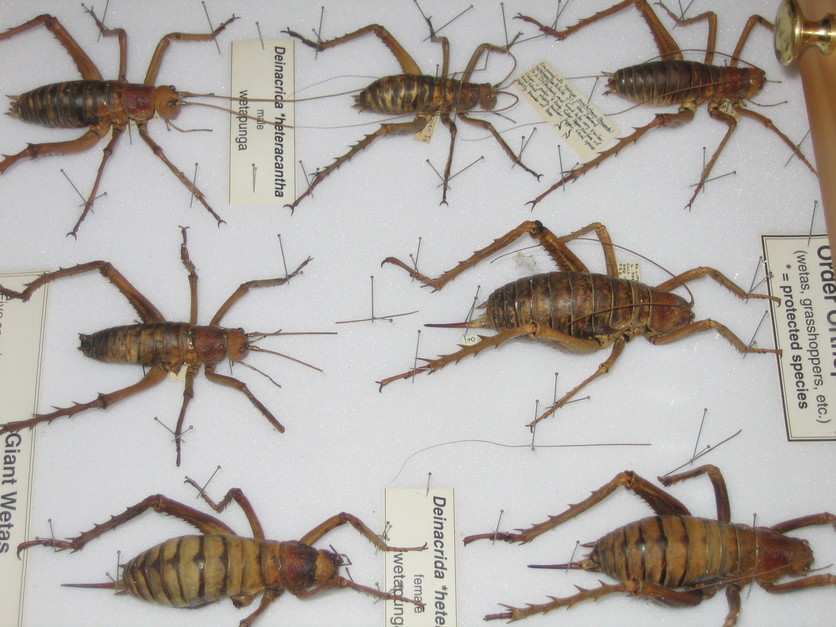The buildings of Manaaki Whenua – Landcare Research in Tāmaki, Auckland, house an enormous range of preserved and live specimens of insects and other invertebrates. Why do the scientists value this collection so highly and what role does it play in conservation.
The arthropod (insects and relatives) collection was started in 1920 and now contains over 6 million different specimens of insects – 90% of specimens were collected in New Zealand, and 18,000 species are regarded as endemic to New Zealand.
Many of the insects are preserved in ethanol to stop the soft tissue from decaying, and around 1 million are pinned. Pinned insects are dried in a position that displays their morphological characteristics (such as wings) before being mounted in large glass-topped drawers. This mounting process and storage in special drawers prevents disintegration.
Every specimen in the collection is tagged with details of its species name, date and place found and the person who collected the specimen. This is a detailed record of the insects that are found around New Zealand.
Why is this collection so important to scientists?
The insect collection held at Manaaki Whenua – Landcare Research is a unique record of New Zealand’s native fauna and forms an important link for both conservation and biosecurity.
Knowing the number and diversity of species that normally inhabit an area is very important when trying to manage conservation and biosecurity. It is very difficult to write a conservation strategy when there is not much information about what species live in what places. What should we conserve? What do the native insects eat? What plants should we protect?
As well as knowing about our native species, we also need to protect New Zealand from invading insects that may damage our environment or our economy. To identify an introduced species, scientists must know what is native to our country.
The collections held at Manaaki Whenua – Landcare Research provide important information for both conservation and biosecurity in New Zealand. The insect collection is like a large reference book. Scientists can refer to the collection to find out if a particular species has ever been found here:
- If a suspected introduced species is detected in a container at a port, it can be compared to all the insects in the collection to see if the species has ever been detected here before.
- If a scientist is collecting insects for research, they may suspect that they have found something completely new, but they need to first compare the insects to other existing specimens before they can conclude whether the new find is actually a new species.
Nature of science
During a court trial, evidence is presented to the jury. When there is an accusation that conservation is threatened or biosecurity breached, we need to produce evidence. Manaaki Whenua – Landcare Research carefully collects, classifies and presents such evidence.
A growing collection
Scientists do find new species in New Zealand. The insect collection is growing by 50–100 new species every year. As scientists find new insects or insects in new locations, the data are collected and the insect is preserved and kept on record for further studies.
Scientist Dr Robert Hoare has found new species of moths in a range of habitats, some as unexpected as an urban park in central Auckland. When collecting specimens, Dr Hoare will record the location, date and other details before taking a specimen back to Manaaki Whenua – Landcare Research and carefully pinning it out for preservation. In the future, scientists can then refer to this specimen to see whether it can still be found at that location or if local changes in the environment mean that it may have disappeared from that habitat.
More work to do
Very little is known about the insect life in New Zealand – perhaps only half of all the insects found here have been named and described by scientists – and of those insects with names, very few have been fully identified in terms of their life cycle and habitat.
There is a lot of work that could be done – for example, new species to find and name – and very few scientists to do it. The resource at Manaaki Whenua – Landcare Research is a unique record of New Zealand’s native fauna, one that is important in protecting and securing the future of this country.
Related content
The work that scientists undertake in finding, classifying and recording native and introduced species is a critical part of conserving New Zealand’s unique ecosystems. Find out more on naming species and the classification systems they use.
Activity ideas
Try these activities with your ākonga:
Useful links
There are thousands of spiders waiting to be discovered in New Zealand. In this Youtube video have an eight-legged experience in Te Papa’s arachnid collection.
The School Journal's Enrich Resources have put together Mini-beast collections on classification, ecosystems, biosecurity and wasps. Search for 'Mini-beast' to find relevant resources.
In this 2022 RNZ programme discover more about the New Zealand Fungarium – Te Kohinga Hekaheka o Aotearoa at Manaaki Whenua – Landcare Research where over a 100,000 fungi specimens are housed.


